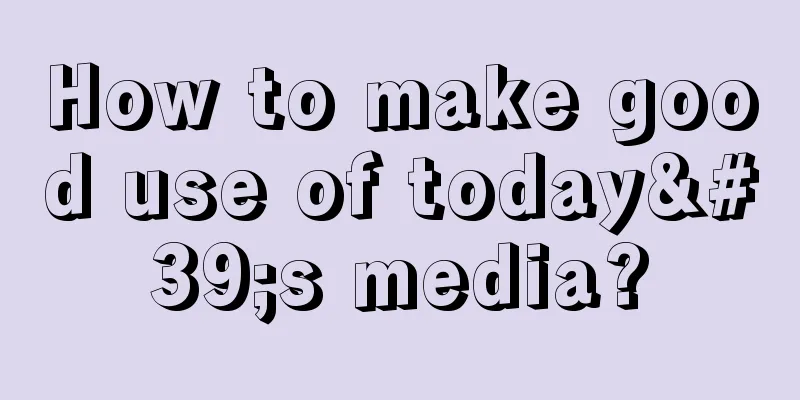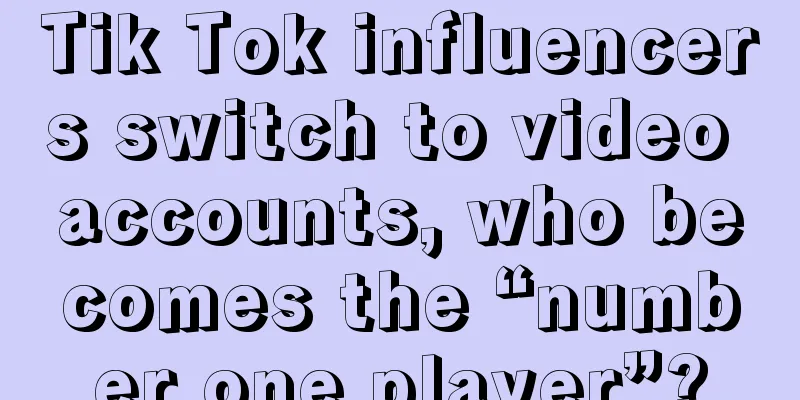How to make good use of today's media?

Media channels are bridges of communication, ways to get information from one place to another. If you have a story, an idea, or a product you want to tell people, you have to find a way to do it, either traditionally or online. for example: Offline, subway and bus station billboards, online short videos, pictures and texts, through which information transcends space and is seen by more people. However, you can feel that media channels are becoming more and more numerous. Not only consumers are suffering, but also brands. On one hand, brands are trying to find the most cost-effective advertising method in a vast array of media. On the other hand, consumers are tired of the information overload, and their acceptance and attention to advertising content are declining. They are a true reflection of the current advertising market and are repeated every day. Heytea and Luckin Coffee will have no less than 20 cross-border activities in 2023. If you think back, which one can you remember besides the sauce-flavored latte? Even if you have a case that is widely circulated, it will still be forgotten in less than half a year. So, the media has changed. 01What has changed? Here is a timeline: 20-30 years ago, information channels were relatively single, and people's attention was more focused. Information was more dominated by leading media, such as CCTV and large Internet portals. Whoever appeared in the prime position could communicate with users. By 2010, marketing began to emphasize big data and precision delivery. The mobile phone market was booming, and various apps sprang up. Brands looked for target users among a bunch of apps and relied on data to speak. In the next 3-5 years, the media will enter a new stage. With the rise of large-scale resource integration and the diversified marketing environment, there is a big idea that links everything together, which is essentially a way to achieve great results with little effort. Later, it was discovered that the disadvantages of this marketing method are obvious. Resources present a pyramid model. The greater the traffic, the scarcer it is, and the price also rises. Take variety shows as an example. When the show is not popular, the price is very low. Once it goes out of the circle, the price will be flipped N times. For brands, the reality is painful. Now, the APP opening screen can also achieve "product, effect and sales three-in-one". It can be seen that the media world has changed from being dominated by television and large portals in the beginning, to using mobile apps and big data to find accurate users, and then to integrating various means to make big moves. Along the way, as technology and the market change, marketing methods are also changing. As everyone flocks to high-traffic areas, advertising costs are rising, which has put a lot of pressure on brands. If we use one word to summarize the whole process, it is "evolution." Evolution is the renewal of technology and strategy, and it also reflects how to adjust the direction according to the new market rules. Why is it called evolution? Because media development clearly demonstrates the transition process from single to multiple. Today’s platforms, such as TikTok, Kuaishou and Xiaohongshu, can provide brands with detailed data, such as people in which city are watching ads, when they are watching ads, and when they will click to see more. A long time ago, Michael McLuhan and Neil Postman pointed out in their books Understanding Media and Amusing Ourselves to Death that media evolution is continuous and operators and advertisers must constantly adapt. At the end of 2023, I saw a self-deprecating joke in the industry circle: Interface co-founder Hua Wei posted a message on his WeChat Moments with a picture asking for placement, indicating that the task might not be completed this year. Then, some friends who work in self-media, subway media, and advertising columns quickly followed suit and posted content, saying that there is no doubt about your business capabilities, you have the final say on the price, and they are ready to invite sponsors at any time. It seems like a joke, but it actually expresses the pressure in the product promotion and advertising industry. This also reminds us that the media world has really changed. What has changed is the trend, the doubts of the client about the effect, and some have not figured out what strategy to use the media channels. 02Back to media placement. In the past, everyone loved watching TV, so advertising on TV could get more people to buy things. This sounded like sales would naturally be good just because of TV advertising. Why is there such growth? Have you ever thought about the underlying logic? Is it because of the lucky TV ads? Or is it because there are just a lot of people watching TV? These are just superficial phenomena, we should think deeper: A group of target users are given a new cognition within a limited range of media. This cognition is the content of the advertisement, and the media is just a channel for receiving information. Can we understand it this way: the ultimate goal of media placement, the underlying logic is: to change consumer perception and reach a new consensus within a closed space. Imagine this: There is an ice cream brand that launches new flavors in the summer. At that time, television was a household entertainment center, and everyone gathered together to watch programs every night; an ice cream brand decided to run an advertisement on a certain satellite TV station during prime time, showcasing a new flavor of ice cream that would bring coolness and happiness after eating. In addition to showing ice cream, the ad also conveys a concept: eating it in the summer is the perfect solution to cool off. So, when viewers watch TV and receive this information, it is likely to leave an impression due to frequent repetition. Throughout the entire process, consumers' perception will be changed to believe that eating this brand of ice cream in summer is the best choice for enjoyment and cooling off. What is the key here? In addition to the ice cream and the advertisement itself, there was also a relatively closed environment for receiving information (in that era, families spent most of their evenings watching TV). in other words: The most fundamental purpose of product promotion is to change people's views in a limited environment and let everyone form a new consensus. It's not easy to change people's minds, but other methods are also effective. Think about sales meetings, how do you convince people completely? Lock people in a room, without any outside information, and keep telling them stories about making money. Over time, these people will believe it. Therefore, the essence of media communication is brainwashing. Repeating certain information in a closed space makes this information become a concept that everyone can accept, thereby changing people's views. This is not difficult to understand. Let’s take a look at what happened when there were more channels. For example: Last year, we provided services for a maternal and infant brand. First, the team worked together to analyze data from various institutions to understand where young mothers learn parenting knowledge and what issues they care about. Based on these insights, media channels were selected that could establish the so-called "cognitive dome" (i.e., information echo chamber effect) among target users. In terms of media strategy, we use online and offline channels, hard advertising and topic discussions, as well as the influence of key opinion leaders (KOLs). By converting soft content into hard advertising, and turning these hard advertising into topics that can be discussed, we achieve synergy in various media forms and build a comprehensive information coverage "dome". For example: When discussing baby health issues, not only are important information posted in elevators, bus stops, and billboards, but the concept is also discussed online, related stories are shared on Weibo, and even on WeChat Moments for interaction. Combining these factors, you will see that different media play their respective roles in different scenarios, forming a kind of synergy. The purpose of doing this is to use both soft and hard methods to make the information quickly penetrate people's minds. No matter where the brand is, it is saying the same thing, and ultimately achieving the effect of repeated brainwashing. 03There's nothing wrong with that, right? But you know what? Brainwashing doesn't work anymore. Because the information environment has become open, all brand communications, within less than a month, have almost no useful assets left except for a bunch of information that can be seen through active searches. What will marketing compete for in the future? I think it’s the brand’s ability to incubate its own assets. What are assets? Through continuous investment, the accumulated resources and advantages that can continuously create compound value include both intangible and tangible ones. To be more abstract: Taking self-media as an example, if a person writes articles every day for a lifetime, apart from accumulating a lot of user attention, it is impossible for him to make any progress online, and users may leave at any time. Because there are too many self-media platforms and a large number of accounts updated every day, users simply cannot keep up, so how can we establish a competitive advantage? Only by organizing articles into works, turning them into intangible (tangible) products that can be sold, can they become assets. For example: Evergrande Ice Spring is a classic case of marketing failure. In the early days of its listing, from the end of 2013 to May 2015, it spent nearly 1.485 billion yuan on advertising in just less than two years. Not only that, Evergrande also invested 6 billion RMB to try to gain a foothold in the market through advertising and sponsorship. Now? Almost no one mentions it. This situation is not uncommon: companies spend a lot of money on advertising, and when advertising investment decreases and product sales are sluggish, companies once again invest heavily in advertising in the hope of increasing sales. In the end, they fall into a strange growth cycle, investing huge amounts of money but achieving little results. The real world and the Internet are two systems. Every time you do something, you are triggering a chain reaction, just like the gears of a watch. If one gear stops turning, time will stop immediately. Brand placement is also a system. Any theme story told by the brand every year and every season must be connected together and turned into a product. In this way, the brand and products will not become bubbles. Look at those brands that have gone through the cycle, what did they do right? Yuanqi Forest has been a relatively popular consumer brand in the past two years. We have done a lot of product promotion before, participating in variety shows, inviting celebrities to endorse, and appearing in programs such as "Running Man", "Let's Go Sports Boys", and "Brothers Full of Energy". We have also invited many celebrities, including Gu Ailing, Su Yiming, Xu Mengtao, Ni Ni, Chen Feiyu, etc. But last year, they changed their business and opened offline live houses, which can be seen in Beijing and Shanghai. At first, I was also confused. Why did a sparkling water company suddenly open a live house instead of doing its main business? Later I realized that there is a large overlap between Yuanqi Forest’s user base and music lovers, and that it has accumulated a lot of brand influence among young musicians. This influence can not only enhance the brand’s awareness, but also incubate more brand assets like starting a side business. Online products are easily forgotten. In this way, a complete industrial chain is actually established, which can form a new business closed loop. Think about it: From integrated marketing, utilizing KOLs, to variety show sponsorship, celebrity endorsements, and live houses, has the entire marketing chain been opened up? Even if users do not participate online, they can be attracted to offline consumption, ensuring that every marketing activity is effective. This model is not unique. For example, Lululemon started out as a pair of pants, focusing on sports and yoga classes in the early stages, and then grew bigger, built a community, and opened offline retail stores. Another example is Xiaomi. At the beginning, it first set up a "Mi Fan Forum" on the Internet, where everyone talked about systems, open source, and technology. Finally, it made mobile phones and sold them to Mi Fans. After the brand became strong, it took a step further to develop an ecosystem of hardware, Internet services, and smart home products. Not to mention Apple. If you look closely, you will find that almost everything from hardware (iPhone, iPad, Mac) to software (such as iOS, macOS) and services (such as iTunes, App Store, Apple Music) is connected. When I was working at Chuchu Street in 2018, I incubated a social e-commerce project called Chuchutui. That year, I also tried to establish offline branches, expand the boundaries, use the branches to drive interest organizations, and finally form new products. However, due to fierce competition among several companies that year, I did not continue. However, later on, many brands of products + self-organization + course extension services appeared on the market, such as Naitangpai, NEIWAI, and Bananain. This is almost a mature business model abroad. 04Therefore, brainwashing communication will be replaced by segmented vertical + interest + service drive in the future. So, how to use the media well? There are three keys: 1) Productizing brand content There are many brands that make their content very classy. For example: Guanxia. I have never bought their fragrances, but I often read their self-media. I even went to the Sanlitun store to check in a few years ago because of my interest. The Fauvism and the Smell Library are places I always want to visit every time I pass by. I also want to visit the M stand and the One-foot Garden Cafe in the Shougang Park in Beijing because I heard they are beautiful for taking photos. This is especially true for Shanghai Auntie. I haven't been there in the past two years, but I always hear people mention it. These brands are good at turning intangible publicity into tangible products, such as cultural derivatives, which are the result of gradually monetizing content assets. B2B business is also possible. For example, professional training can be turned into a relaxed learning gathering or salon, where registration fees are charged, so that people can learn and get to know each other, and the information can be disseminated again. You can also join forces with several partners to create festivals, etc. Any brand, as long as it has content, has the opportunity to take a different path. 2) Provide users with new carriers It’s critical for brands big and small to tap into the potential of super users, who come in two main types: The first type is loyal customers who purchase frequently and place orders frequently. These users frequently purchase products through platforms such as JD.com, Taobao, and Douyin, and are recorded by the CRM system. Some companies have already formed private domain traffic, which can help brands better understand consumer needs and optimize products. The second type is people who don’t make many purchases but actively spread information online and are interested in brand activities and values. They share information to help brands expand their influence and attract more potential customers. If you want to keep them, the most effective way is to plan more activities around their interests and hobbies, whether online or offline, and invite them to participate. In this way, information can spread quickly like a flywheel. In the end, the brand will slowly become a platform, an information container, providing not only products but also more content and activities that match interests, forming a new culture. 3. Use carriers to promote new consumption If your brand cannot be implemented in real offline scenarios like others, you might as well combine other scenarios to design one or a series of experiences directly related to consumer needs. This experience may be a sentence or a small action, but it gives people a completely different feeling. When you take a plane, there will be a mother and baby room next to the bathroom. Last time at the Daxing Airport, I saw a brand’s logo next to the mother and baby room with a slogan about caring for your baby’s health, and below it was a QR code and some information about brand activities. I scanned it out of curiosity and the page showed: If you have any needs in maternal and child care, we have lectures for you, which you can view through the online APP. He also said that no matter which city you are in, you can come to our open classes to help you solve the problems you encounter as a first-time parent, and there will be more rich activities waiting for you to participate . This touched me deeply. In summary: Everything is changing, and yet nothing is changing. How to use media channels well? There is a general principle that brand owners should re-examine their target group and what more detailed things they should do for them. Then, use media channels to help me tell fresh themes, new content, and new stories. It is best to gradually productize the content to support your business. Author: Wang Zhiyuan, public account: Wang Zhiyuan |
<<: To analyze indicator fluctuations, the data model should be built like this
>>: 10,000 words sorted | 35 essential models for brand marketing strategy
Recommend
How to change prices on Shopify? What are the tips?
When doing cross-border e-commerce, the relevant p...
Revelation of Domestic Product Marketing
The recent hot topic is the Li Jiaqi and Hua Xizi ...
How is Amazon's new product period calculated? What are the rules for the new product period?
Amazon is actually the same as other platforms. It...
The user portrait built with the SIKT model is so easy to use!
The biggest fear when doing user portrait projects...
These three models are super useful for Internet product analysis!
This article deeply analyzes the three major types...
Will Amazon's store be closed immediately after being linked? Analysis of the reasons why Amazon closed the store
There are many rules on the Amazon platform that a...
How to set the base currency of Shopee? How to operate Shopee?
Friends who are engaged in cross-border e-commerce...
WeChat Video Account is a runner-up in this Double 11
Compared with other platforms that are making a bi...
10 suggestions from friends after 618
Weak consumption may be caused by a variety of fac...
At the end of the year, massage technicians are on duty
At the busy end of the year, we might as well stop...
The truth is always hidden in the comments section
As long as it is a social platform, there is a com...
Is universal empathy the new standard for hit dramas? How does "The Story of Rose" make its brand stand out?
The story of Rose became a big hit, and it was not...
To shoot short videos on Tik Tok, it is enough to master these 12 traffic codes
This article shares 12 key points for shooting a p...
The new decade of second-hand e-commerce
In the new decade of the second-hand e-commerce in...
“AI Resurrection”, comfort or business?
In recent years, the topic of using AI technology ...









